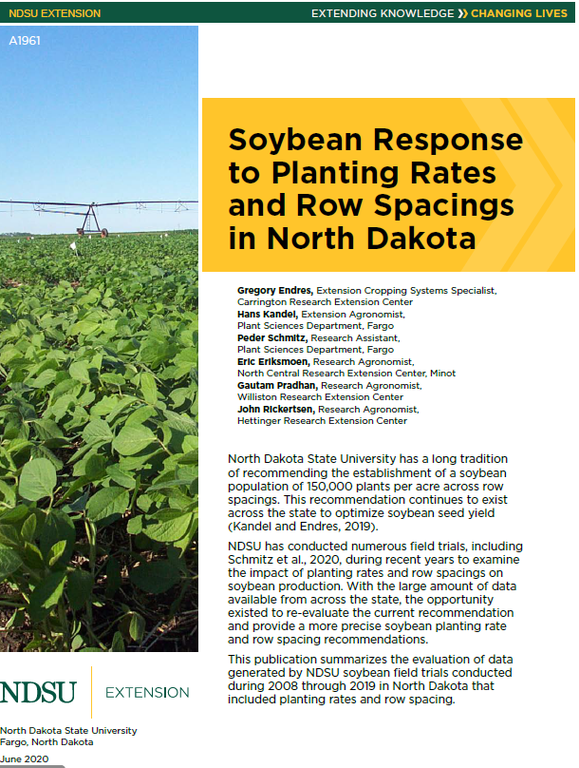Center Points
Cover Crops: Living Their Best Half-life
Most will agree that cover crops do good things for soils. Cover crops also add to cropping system complexity and have costs associated with them. One of my recent research goals is to remove cover cropping barriers by better understanding potential reasons for failure. Dry conditions are one of the primary causes for lack of establishment and growth. Herbicide programs are another consideration that can cause establishment problems, but this issue can be navigated. Here are a few tools to get started:
This chart identifies the herbicide carryover risk associated with planting cover crops in the fall after spring wheat harvest (tested in North Dakota). https://www.ag.ndsu.edu/carringtonrec/documents/agronomyrd/docs-2017/2017-cover-crop-safety-following-wheat-herbicide-application/view. This information is also found in the ND Weed Control Guide. The 2021 ND Weed Control Guide will also contain a similar table for soybean herbicides.
Herbicide carryover is affected by several factors including rainfall, soil pH, soil organic matter content, soil biological activity, and soil texture. The rate of herbicide breakdown is measured through half-lives. If you remember from high school chemistry, a half-life is the amount of time it takes to degrade half of the product. For instance, if the herbicide has a half-life of 40 days and was applied at 10 oz/a, after 40 days there would be 5 oz/a left, at 2 half-lives (or 80 days) there would be 2.5 oz/a remaining. For most herbicides the rate of decay varies, sometimes wildly, depending on the factors listed above. It is useful to understand the half-life of an herbicide, how the herbicide is degraded, and how the speed of degradation may be affected in a specific field/environment. The herbicide carryover section of the ND Weed Control Guide is a good place to start (page 110 in the 2020 version).
We conducted a demonstration study in the greenhouse this winter to illustrate differences in half-lives. Table 1 lists the effect of micro-rates of herbicides to simulate different half-lives, and the effect those rates had on cover crops. This is listed as the percent of the non-treated check (so 0% means there was no growth). On the right-hand side, the half-life ranges of the products are listed. Many commercial herbicides contain more than one active ingredient. This means that a one product can have multiple half-lives. For instance, Widematch contains clopyralid and fluroxypyr, which degrade at different rates and affect different cover crop species. (Note that for simplicity, I only listed two of the four active ingredients in Acuron).
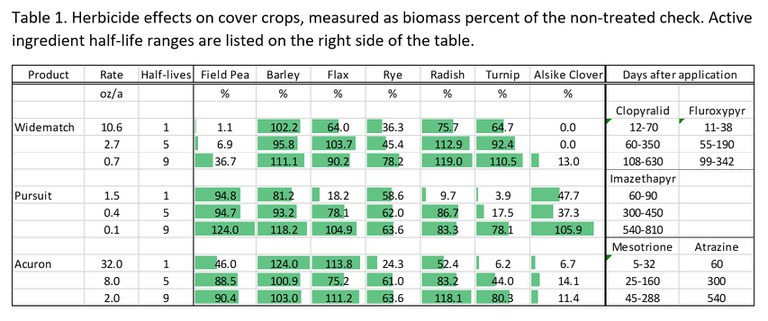
The key message is that when planning for cover crops, the herbicide program needs to be considered. Some herbicides can still suppress cover crop species more than a year later. However, conditions like high organic matter, high rainfall, and high biological activity reduce the effective persistence of herbicides by up to 500 days (I’m looking at you, clopyralid x clover!). In fact, microbial degradation is the primary driver of herbicide breakdown in all the products listed. This is complicated material, but now is the time to consider your options. Also consider that with the dry fall, herbicide carryover risk is starting out greater than normal.
Mike Ostlie, Ph.D.
Mike.Ostlie@ndsu.edu
Research Agronomist
Long-term Cropping Study - Nitrogen Fertility Revisited
Last month we discussed the impact of tillage system on grain yield.
This month we will look at nitrogen fertility treatments.
The fertilizer treatments are: (1) urea broadcast applied each spring to all plots, except field peas and soybeans, at 0, 50, 100, or 150 pounds of N per acre and (2) composted beef feedlot manure applied once at 200 pounds of N the first year of each cycle. These treatments are imposed in strips perpendicular to the three tillage systems: conventional, minimum tillage, and no till resulting in 15 sub-plots within each crop.
 Long term cropping study with tillage systems running vertically in the plots and the N fertility rates running laterally in the plots.
Long term cropping study with tillage systems running vertically in the plots and the N fertility rates running laterally in the plots.
Note: Composted manure sunflower plots were negatively impacted by preferential deer grazing most years.
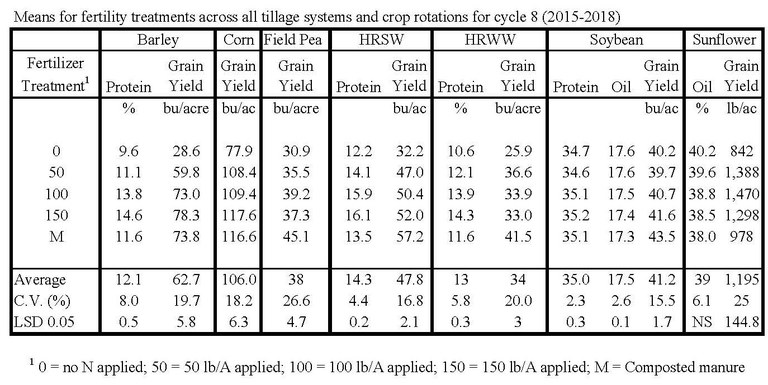
As shown in this table, cycle eight yield tended to increase with increasing nitrogen rates. The composted manure treatment performed as well as comparable commercial fertilizer rates in the non-legume plots. The yield in field pea and soybeans were higher, possibly due to increased phosphorous and micronutrients allowing nitrogen fixation and nitrogen scavenging from higher organic matter mineralization. However, the protein content of the wheat crops was limited by the composted manure treatment, resulting in a significant price penalty at market. Soybean protein content was lower for the previous 0 & 50 pound rates, and as a result, oil content was higher. However, neither had a negative impact on price received at the elevator.
This is a complex study with many moving parts - please contact me to discuss particular points.
Ezra Aberle
Ezra.Aberle@ndsu.edu
Agronomy Research Specialist
Soybean Yield Response to Planting Rates and Row Spacings in North Dakota
North Dakota State University has been conducting field research on soybean planting rates and/or row spacing for decades. NDSU also has had the long-term recommendation for soybean plant stand of 150,000 plants per acre across row spacings. In 2020, data was compiled and evaluated from 37 NDSU trials conducted during 2008 through 2019 across the state. The objective was to provide a more precise guide for establishing soybean stands, using seed yield response data among regions in the state, based on the combination of planting rates and row spacings. This work resulted in publishing the NDSU Extension circular A1961 ‘Soybean response to planting rates and row spacings in North Dakota’.
The following is a summary of the research data:
Individual factors
- Across North Dakota and row spacings, the planting rate of about 170,00 pure live seeds (PLS) per acre optimized soybean seed yield. In eastern North Dakota trials, 8% of planted PLS per acre did not develop into viable soybean plants. Assuming 8% of PLS does not result in established plants across North Dakota, and using 170,000 PLS per acre, about 155,000 plants per acre would be expected to maximize yield. Within regions, optimum yield occurred with 180,000 and about 140,000 PLS per acre in eastern and western North Dakota, respectively.
- Across North Dakota or by regions, narrow rows (less than 15 inches) consistently provided greatest soybean yield.
Factor combination (by regions)
- In eastern North Dakota, the combination of narrow rows (12 to 14 inches) and planting rates of about 170,000 PLS per acre provided optimum yield. If planting in wide rows (24 to 30 inches), planting rates to reach the optimum yield were about 190,000 PLS per acre.
- In western North Dakota, the combination of narrow rows (7 to 10 inches) and planting rates of about 150,000 PLS per acre provided optimum yield.
See table for estimated early season plant stands based on PLS per acre planting rates minus selected percentages of plants not established due to field loss.

Note the above planting rates are for optimum yield. Economic yield must also be considered based on seed costs.
Greg Endres
Extension Cropping Systems Specialist
Gregory.Endres@ndsu.edu
Hans Kandel
Extension Agronomist and Professor
Hans.Kandel@ndsu.edu
Yield Impact of N Applied to Corn at Tasseling
Objectives
- Verify whether N fertilization at tasseling (VT) would improve corn yields in North Dakota
- Assess whether yield response to split N will differ between dryland and irrigated corn
- Determine if improved yields would justify the cost of late N application?
Methods
Two trials were conducted on dryland and under irrigation at Oakes, and one under irrigation at Carrington, ND. 14 fertilizer treatments were applied. The first six N treatments were pre-plant N at 0, 40, 80, 120, 160, and 200 lbs N/ac. Eight other treatments were splits that either received 0 lbs, 40 lbs, or 80 lbs N as starter, plus 40 lbs N top-dress at either V8 or at tasseling (VT).
Results
- Yields responded positively to N at Oakes. Yields did not respond to N at Carrington; thus, the split N results were not important.
- Maximum yield at Oakes was 259 bushels at 200 lbs N under irrigation, and 195 bushels at 200 lbs N on dryland. Yields were not significantly different between 200 and 120 lbs N either under irrigation (227 bushels) or on dryland (186 bushels).
- Even though split application of N at a total rate of 120 lbs N did not result in statistical yield differences the response to split N application was different between the irrigated and dryland sites.
- Under irrigation, split application of 120 lbs N produced higher yields than a single application at planting. The split N treatment that received 40 lbs as starter, 40 lbs at V8, and 40 lbs at VT (40-40-40) produced the best yield at 120 lbs N total (Fig 1). It is probable that when the fertilizer was split, it prevented some N loss due to leaching. The soil is well drained; frequent irrigation would have probably moved some of the N below the reach of the roots (leaching).
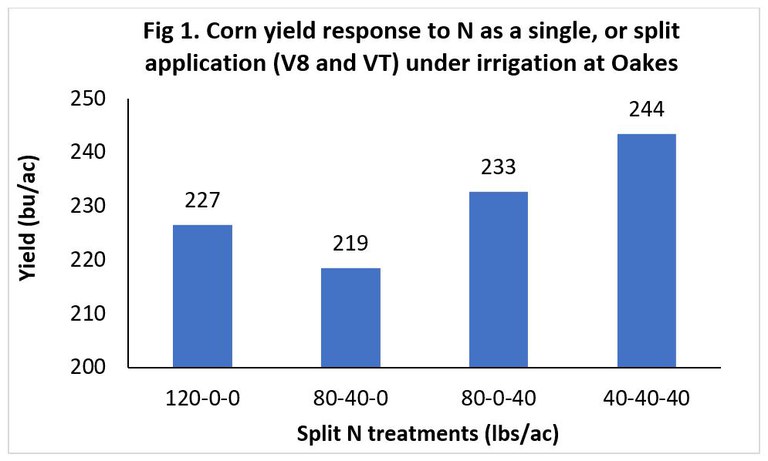
- On dryland, application of all 120 lbs N at planting produced the highest yield when compared to split application treatments (Fig 2). Because the dryland field had received beddings in fall the previous year, some of the N may have been tied up, and as a result, much N needed to be availability early and throughout the growing season.
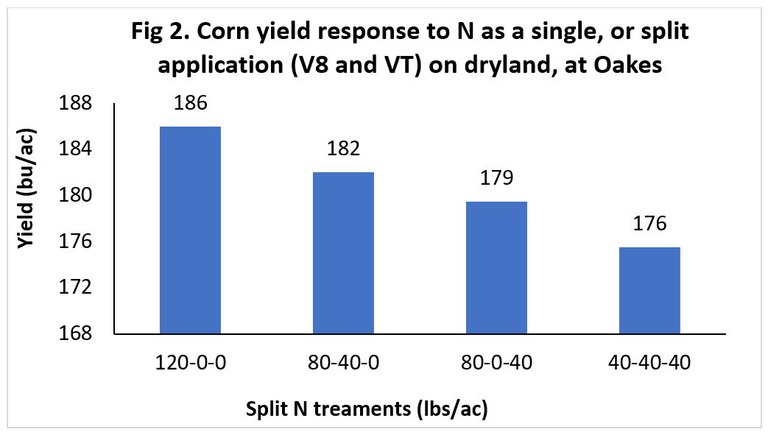
Conclusion
In environments of high rainfall or where irrigation practiced, split application of N would be recommended to minimize N loss to leaching. Due to lack of significant yield differences between the single and split N applications it would have been uneconomical to have applied N later in the growing season. Nonetheless, split-application of N with most of the N applied at planting, and the rest around V6 to V8 remains a safe strategy to minimize N loss and enhance N fertilizer use efficiency in corn.
We gratefully acknowledge funding from the North Dakota Corn Council in support of this research.
Jasper Teboh, Ph.D.
Jasper.Teboh@ndsu.edu
Soil Scientist
Maintenance and Development of Agronomy Research Equipment
A part of the team at the CREC that often is not referenced in our information releases are research technicians who shift their emphasis at this time of year to maintenance, repair and sometimes the creation of new agricultural research equipment. The CREC’s research programs that address crops and soils related issues represent a major part of the overall mission of the department. Each year the agronomy and soils team conducts more than 400 individual field trials to investigate identified needs among the many crops grown in North Dakota. To conduct research on this wide range of crops and different production systems, we rely on many different pieces of equipment. Most research equipment is smaller scale than traditional farm equipment and often is very specialized. We are able to purchase a majority of this equipment from companies that design and manufacture specialized equipment for agricultural researchers worldwide. However, some equipment we use is difficult to source due to the unique need within a research project or the significant cost from a company that supplies research equipment. In those cases, the CREC looks to our team of talented technicians to manufacture the item from scratch or modify a piece of traditional farm equipment to fit our research need.
The lineup of equipment available to our researchers is represented by a number of items that were modified to fulfill research applications. Following are examples of equipment that have been modified or fabricated to meet our needs.
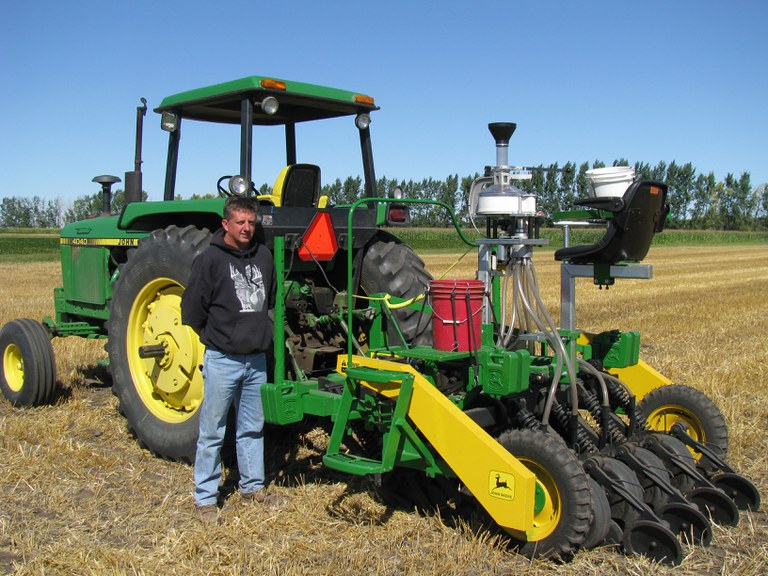 No-Till plot drill, branded openers and seed divider mounted on framework designed and built by CREC technicians. Planter depth control, unit down pressure and residue management were not available from research equipment manufacturers at the time this was built.
No-Till plot drill, branded openers and seed divider mounted on framework designed and built by CREC technicians. Planter depth control, unit down pressure and residue management were not available from research equipment manufacturers at the time this was built.
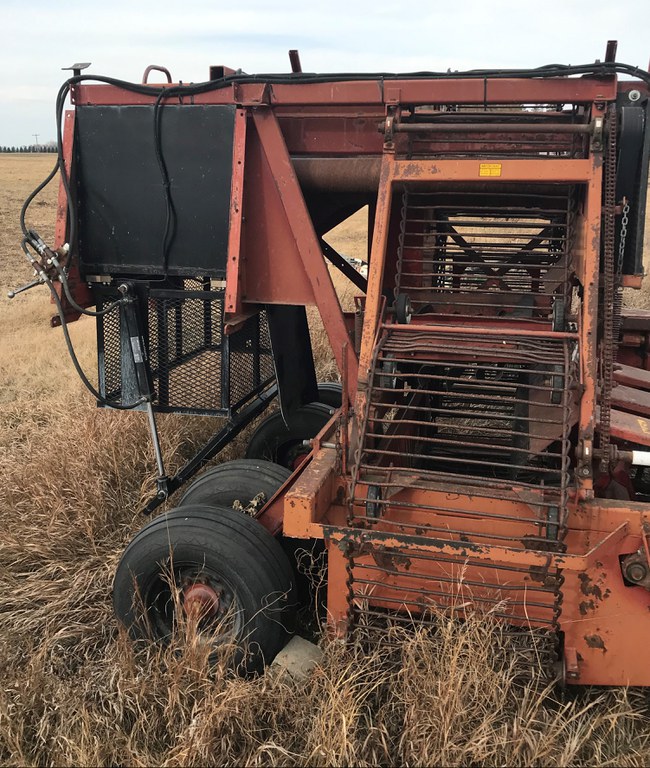
A used 4-row lifter donated by Amity was modified to become a 2-row unit that deposited lifted beets into the mounted hopper with load cells to serve as a weighing system.
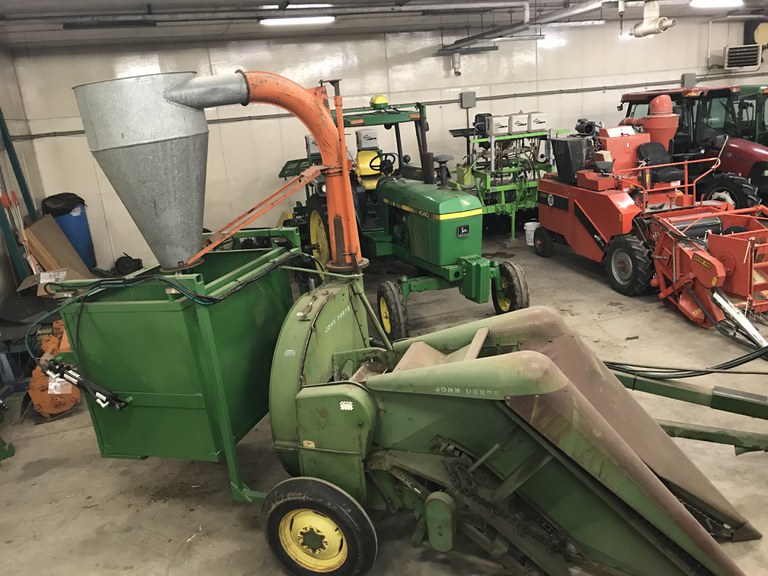 A vintage, John Deere No.8, 1-row corn chopper that was used for research at the Center many years ago was further modified to include a hopper and weighing system to collect and weigh chopped silage with improved safety and operation by one person.
A vintage, John Deere No.8, 1-row corn chopper that was used for research at the Center many years ago was further modified to include a hopper and weighing system to collect and weigh chopped silage with improved safety and operation by one person.
This winter our team of technicians will be focused on the regular maintenance and repair of equipment such as the tractors, planters, sprayers and combines. For some of the older harvest equipment and planters they get fairly creative since often the part is no longer available so they improvise! They also have a couple of build projects on their itinerary. Two 1960’s-1970’s era tillage implements are being modified to become seedbed prep/soil finishing tools that fit the scale and soil conditioning needs required within our agronomy research program. We are thankful to have these resourceful staff who put our scientists in the best position to effectively address the needs and priorities of our producers.
Blaine G. Schatz
Blaine.Schatz@ndsu.edu
Director/Agronomist
Organic Oat Variety Evaluation and Development
Organic agriculture poses unique challenges for the organic farmer with some of the challenges being the availability of certified organic seed or seed developed in certified organic fields. A finding from the State of Organic Seed 2016 by the Organic Seed Alliance (OSA) illustrate that “more farmers believe organic seed is important to the integrity of organic food production and that varieties bred for organic production are important to the overall success of organic agriculture.” Surveys from OSA also illustrate the use of certified organic seed by certified organic farmers tends to be low with percent usage varying by crop type. Results demonstrate that farmers are attempting to source more organic seed. Although the use of organic seed is increasing, there are a number of reasons why organic farmers are not using organic seed: variety choice, insufficient quantities, lack of desirable traits, and price. Overall, the organic seed supply is not keeping up with the growth in organic sales with organic farmers still relying on conventionally produced seed.
The USDA’s National Organic Policy (NOP) requires the use of organic seed when commercially available. When the NOP began, the organic seed sector barely existed. Currently there are few public and private breeding programs focusing on the development of organic seed. A basic principle in plant breeding is that to “breed and select in the environment of intended use,” and for organic agriculture, that means selection and development in certified organic fields.
One of the main efforts with organic research at the CREC has been varietal evaluations across a number of field crops to provide information on the best varieties for organic farmers to plant. Lately we have begun evaluating early generation nurseries from a number of plant breeders in the region to aid in organic variety development.
This past year we partnered with a number of plant breeders, both private and university, to evaluate experimental oat nurseries on the CREC organic plot ground. We are cooperating with Dr. Mike McMullen (NDSU), Dr. Melanie Caffe-Treml (SDSU), Dr. Jennifer Mitchell Fetch (retired) and Dr. Kirby Nilsen (Agriculture and Agri-Food Canada), and Mr. Paul Richter (General Mills).
The breeding programs at SDSU and Agriculture and Agri-Food Canada focus on developing varieties in both organic and conventional environments. Examples of released varieties from these two breeding programs for organic agriculture are AAC Kongsore and Oravena from Agriculture and Agri-Food Canada and Sumo from SDSU. The breeding programs at NDSU and General Mills currently are not specifically breeding for organic while they are looking more at cultivars that perform well in both conventional and organic environments.
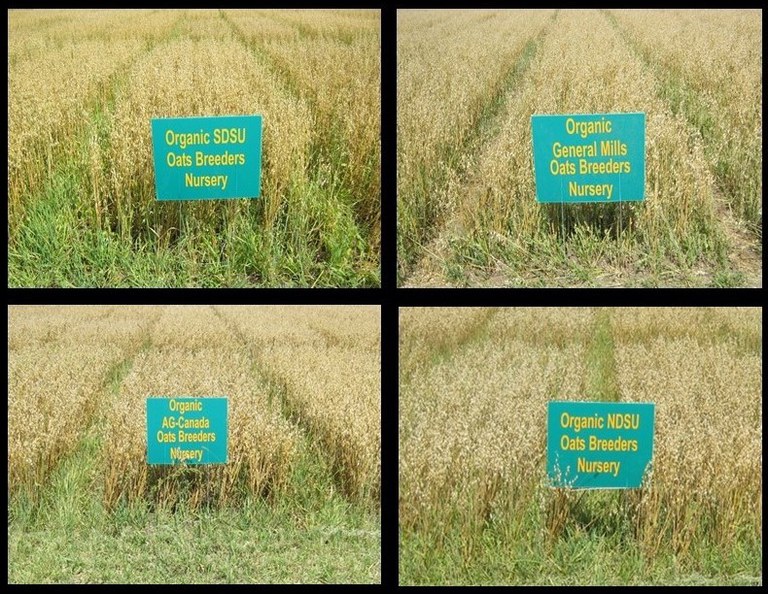
Results from these nurseries are generally not available to the public with the exception of check varieties. Check varieties are used for comparison purposes by the plant breeders to determine what experimental lines they will include in advanced trials.
Steve Zwinger
Steve.Zwinger@ndsu.edu
Agronomy Research Specialist
Long-term Cropping Study – Tillage Systems at the Completion of Another Cycle
In 1987, a long-term cropping systems study started at the NDSU Carrington Research Extension Center. This is the longest replicated cropping systems trial in North Dakota.
Three sets of 4-year crop rotations are replicated three times each year. The eighth cycle ended in 2018. The original crop rotation, maintained until 2003, was: Hard Red Spring Wheat/Sunflower/Barley/Fallow. At the beginning of the fifth cycle in 2003, this crop rotation was updated to replace Fallow with Soybean. The other two current crop rotations are: Hard Red Spring Wheat/Field Pea/Corn/Soybean, and Hard Red Winter Wheat/Corn/Soybean/Hard Red Spring Wheat. Each crop within each rotation is planted every year.
The fertilizer treatments are: (1) urea broadcast applied each spring to all plots, except field peas and soybeans, at 0, 50, 100, or 150 pounds of N per acre and (2) composted beef feedlot manure applied once at 200 pounds of N the first year of each cycle. These treatments are imposed in strips perpendicular to the three tillage systems: conventional, minimum tillage, and no till resulting in 15 sub-plots within each crop.
We’re going to revisit tillage systems. This study is located on a Heimdal silt loam soil. The main plots are 180 ft. by 300 ft. and field scale equipment is used.
The conventional tillage system starts with disking to a depth of approximately three inches shortly after combining. This is followed by chisel plowing later in the fall prior to freeze up. In the spring, the ground is worked with a field cultivator prior to seeding or planting.
The current minimum tillage has become more of a rotational tillage system. It was changed to reflect current reduced tillage farming practices of the area. It is essentially not tilled except for the fall prior to the corn and sunflower rotations. That fall and the following spring it is worked just like the previously mentioned conventional tillage treatment.
The no-till treatment is just as it sounds: there is no tillage performed except what disturbance is created by the disk drill or planter. Instead of tillage, a chemical burn down with herbicides is performed in the fall for weed control after combining and again in the spring for weed control prior to seeding.
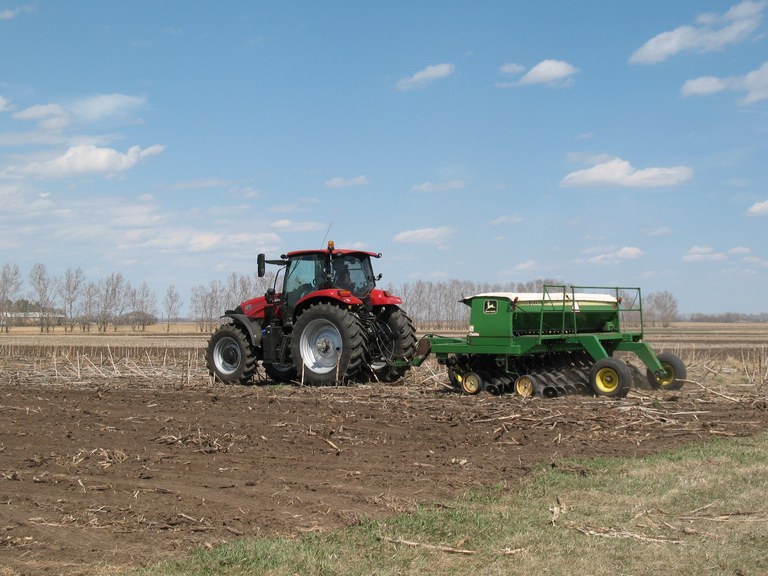 Seeding barley. Conventional tillage in foreground and no-till under the tractor and drill.
Seeding barley. Conventional tillage in foreground and no-till under the tractor and drill.
Conventional tillage exhibits less than 30% residue cover after planting and the no-till system has greater than 80% residue cover after planting.
For each tillage system, appropriate herbicides are used for weed control within the crop production season.
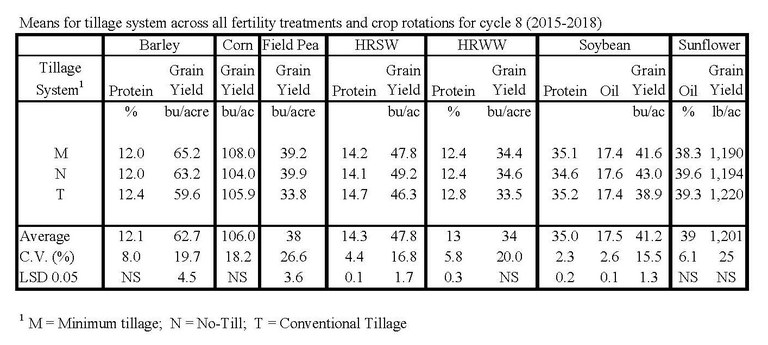
As you can see from the cycle eight table above there was no negative impact on grain yield when reducing tillage. Reduced tillage did statistically impact protein content of soybean (positively) and the wheat (negatively, yet not enough for a dockage at the elevator.)
Ezra Aberle
Ezra.Aberle@ndsu.edu
Agronomy Research Specialist
Foundation Seed Update
What a difference a new year can bring. Last year, early October 2019 brought 24” or more of snow and shut down fall harvest. Fall 2020 has been almost perfect for harvest as hardly any moisture has fallen since the middle of July. This season’s fall surprise was an early September 8-9 frost that shut down growth on row crops. This frost will likely cause lower germinations as some soybeans were still green and not fully mature.
Beyond fall field work, current preparations include lining up seed for next season. Our seed stock program has produced and harvested a diversity of crops including new varieties that will present more options for spring. Listed below are the foundation varieties that the CREC has available for 2021.
- Spring Wheat: Faller, ND Frohberg, Glenn, Shelly, MN Torgy, MN Washburn and ND VitPro
- Durum: Divide, ND Grano, Joppa and ND Riveland
- Barley: AB Advantage, CDC Bow, ND Genesis and Pinnacle
- Field Pea: ND Dawn
- Flax: AAC Bright, Omega and York
- Soybean: ND Benson, ND Dickey, ND Rolette and ND17009GT
- Buckwheat: Manor
- Winter Rye: ND Dylan and ND Gardner
CREC releases include two new spring wheats, a field pea, two Canadian barleys and a Canadian flax. These varieties will be protected under Plant Variety Protection (PVP) Title V. They must be sold as a class of certified seed.
ND Frohberg is a new NDSU spring wheat release. The seed possesses high quality comparable to Glenn and ND VitPro. ND Frohberg is a variety with good standability and good yield potential along with a good disease package. It will be released and distributed through the counties in 2021. ND Frohberg is licensed and managed through the ND Crop Improvement and Seed Association.
MN Torgy is a 2020 spring wheat release from the University of Minnesota. It has a good combination of yield and protein. It has a shorter than average height with good straw strength and a good disease package. MN Torgy can be purchased directly through the CREC.
AB Advantage is a tall six-row smooth awn forage/feed barley from Alberta. It has high yield and high forage potential. Yield is comparable to or higher than Celebration. AB Advantage is licensed and managed through the ND County Crop Improvement and Seed Association.
CDC Bow is a two-row malting barley variety released in 2018 by SeCan. CDC Bow is a high yielding, average protein barley. It has a high percentage of plump kernels and strong straw strength. CDC Bow is licensed and managed through the ND County Crop Improvement and Seed Association.
ND Dawn is NDSU’s first new yellow seeded pea, released last year. It has DS Admiral as a parent background. The seed is large and smooth. ND Dawn has good yield potential and good standability. ND DAWN is licensed and managed through the ND Crop Improvement and Seed Association.
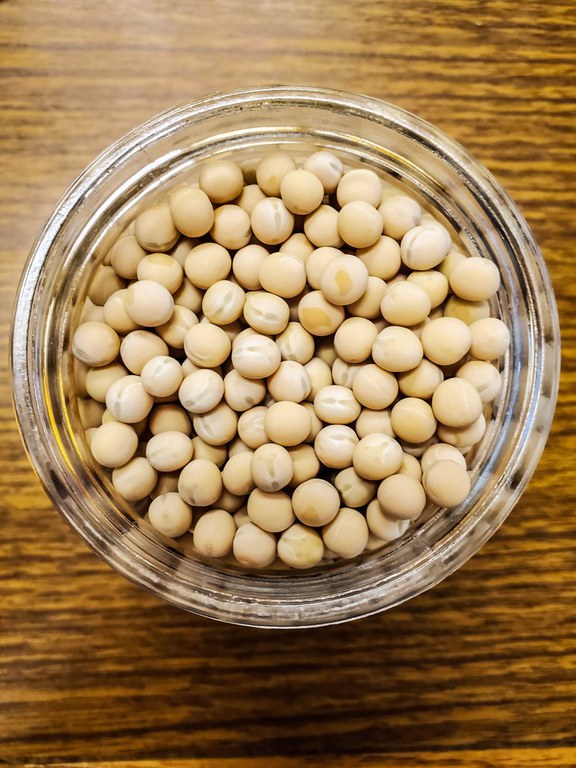 ND Dawn is a yellow-seeded pea.
ND Dawn is a yellow-seeded pea.
AAC Bright is yellow flax released by SeCan. The seed coat has a very bright yellow appearance and the seed contains a high oil percentage. It has a high yield potential with good standability. The variety is tall and long maturing. AAC Bright is licensed and managed through the ND Crop Improvement and Seed Association.
If you are interested in these varieties, call the Carrington REC at 701-652-2951, e-mail myrna.friedt@ndsu.edu, or call Dave Copenhaver at 701-652-5853. Other cultivars and additional quantities may be available from other NDSU Research Extension Centers and the Agronomy Seed Farm. The NDSU Foundation Seedstocks Pricing Committee will set seed prices for this year’s seed soon and the prices will be published in the near future. Within the NDSU Foundation Seedstocks program, seed orders received by December 1 will be given preference and priority when allocating foundation seed.
Dave Copenhaver
David.Copenhaver@ndsu.edu
CREC Seedstocks Research Specialist
Soybean Response to Distillers Grains as Sources of Phosphorus
Recent wheat and corn studies from Carrington have shown that distillers grains are a good source of available nutrients when applied on cropland. Yields from distillers grains were always greater or similar compared to triple super phosphate (TSP) granular phosphate fertilizer.
In 2020, dryland and irrigated trials were conducted to examine the effect on yields and nitrogen fixation (ureide content) of soybeans following application of distillers grains at rates to supply 40 lbs of phosphorus (87 lbs P2O5).
Wet distillers grains (WDG) was applied at 1.8 T/ac, and condensed distillers solubles (CDS) was applied at 190 gal/ac. WDG also supplied 66 lbs N, and CDS supplied 33 lbs N. A control treatment received no P fertilizer, but received 33 lbs N from urea. All treatments were either incorporated or left on the surface.
RESULTS
Yields under irrigation were low compared to dryland (Fig 1.), even though both trials were fertilized just a day apart, but incorporated and planted same day. Yields were not negatively impacted by distillers grains application.
Under dryland, yields from P fertilized plots and incorporated treatments were numerically greater than from the control treatment (no P fertilizer).
Under irrigation, yields were neither affected by fertilizer treatments nor method of application.
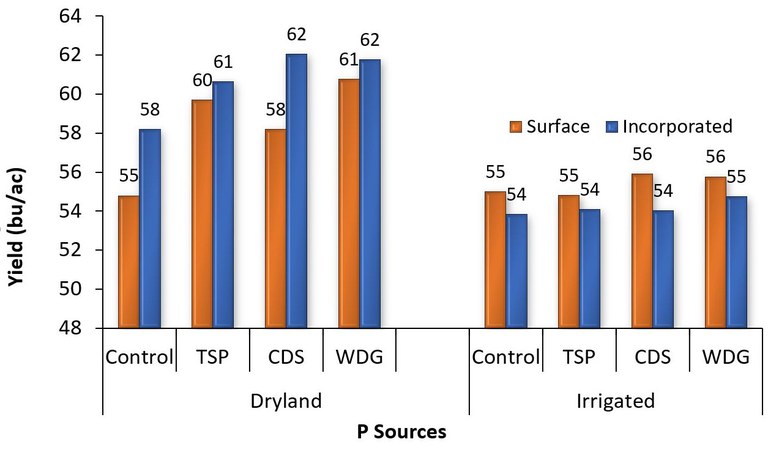
Fig. 1. Yields of dryland and irrigated soybeans in response to distillers grains and granular fertilizers as sources of phosphorus applied and incorporated, or left on the surface.
There was no evidence that N fixation (ureide content) was adversely impacted by the higher N (66 N/ac) supplied with WDG when compared to the 33 lbs N from either CDS or urea. This could be due to a slow but gradual release of the N available from WDG.
Acknowledgement: This research was funded by the North Dakota Soybean Council.
Jasper M. Teboh, Ph. D.
Jasper.Teboh@ndsu.edu
Soil Scientist
A Sneak Peek at 2020 Wide Row Corn Results
In 2020 many growers and researchers were awakened to the concept of growing corn on a wider row spacing (often called 60” corn). This is counterintuitive to the trend of narrowing rows for maximum yields. So what is the fuss about?
The goal of this system is to maximize the harvest of light on each plant. The wider rows create alleys where direct sunlight can still hit the bottom corn leaves (and a cover crop). The reason for switching to this system varies, but most often involve incorporating cover crops. In North Dakota, a mid-season cover crop planting into corn suddenly becomes the most realistic way to get cover crops into a crop rotation, due to dry conditions and time constraints in the fall during traditional cover crop planting windows. There are many benefits to cover crops in a system, but this cropping system seems especially favorable to livestock integration.
This past year we were able to experiment with the practice at the CREC and Oakes Irrigation Research Site. The goal of our study was to evaluate corn yields at different row spacings (60” vs 30”), plant populations, and row orientations (north-south vs east-west). Here is a snapshot of what we are seeing:
- We were expecting big differences in yield and cover crop growth between north-south and east-west rows, but that didn’t happen. Overall our conditions were quite dry and limited both cover crop establishment and corn yields. The moisture shortage likely limited the differences between row orientations.
- As expected, cover crop were established at a much higher rate with wide rows compared to narrow rows. With wide rows, there was roughly 40% of the expected cover crop stand, whereas with 30” rows only 14% of expected covers grew. Higher corn populations reduced cover crop stand at both row spacings.
- At equal populations (32k/a), the 60” rows yielded 5-7% less than the 30” rows. With wide rows, reducing plant population to 24k reduced corn yields by over 10%, and 16k reduced corn yields by another 10%. The same patterns existed for both row orientations.
- Cob length was not affected by any of the treatments, but the number of kernel rows increased by 2 in the wide row treatments. Plant height was not affected by any treatment.
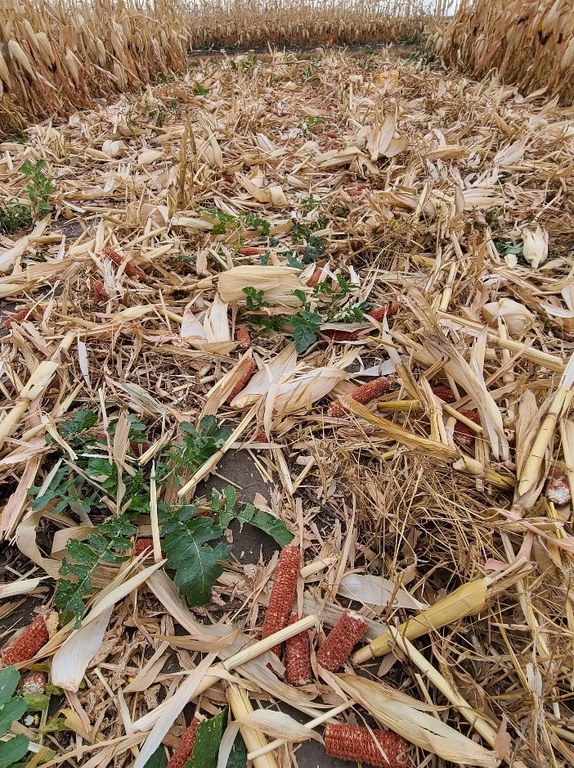
Cover crops from 30" rows
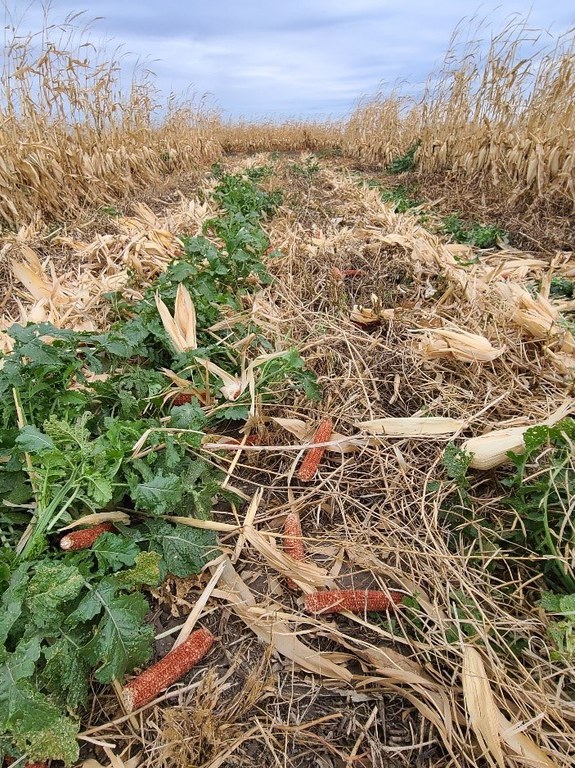
Cover crops from 60" rows
Stay tuned for more information about wide row corn! There is a lot to learn as we find out what did and did not work with our regions’ farmers in 2020.
Mike Ostlie, Ph.D.
Mike.Ostlie@ndsu.edu
Research Agronomist


